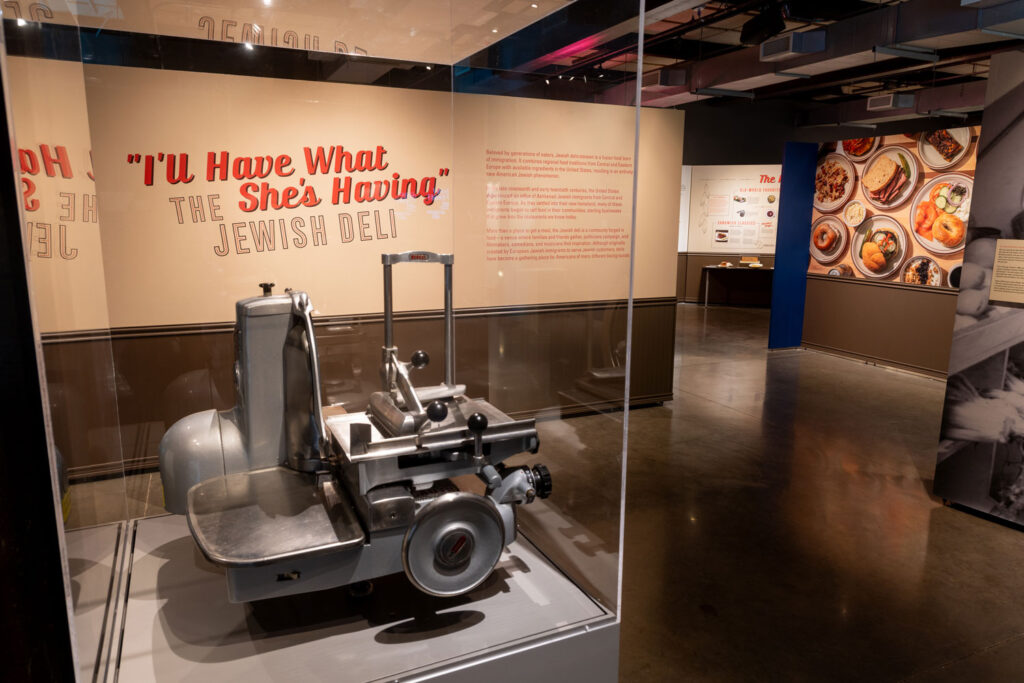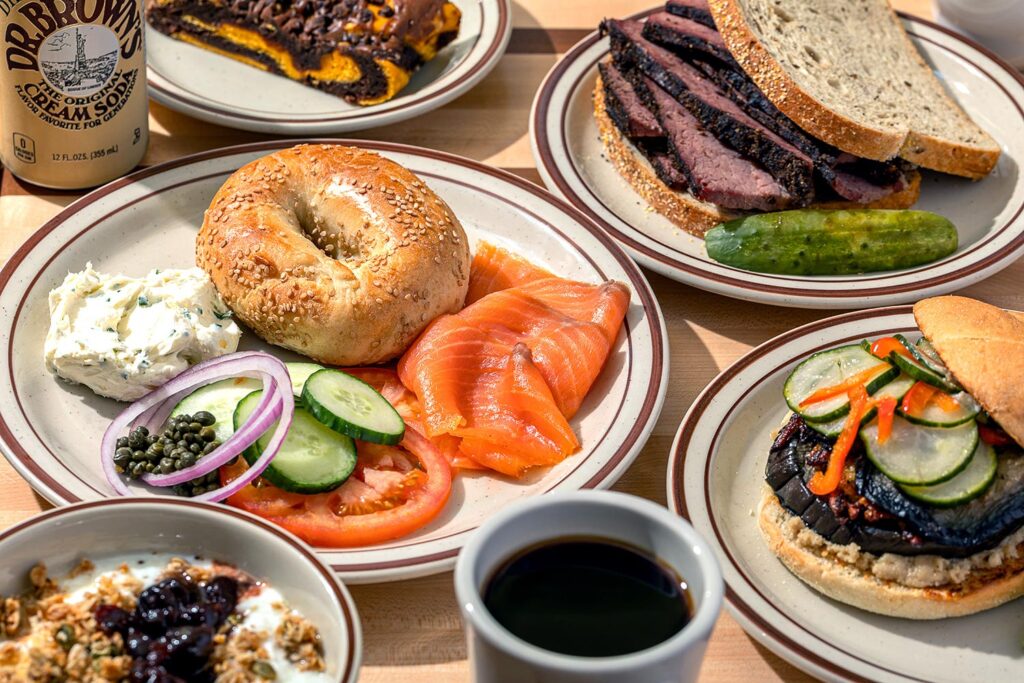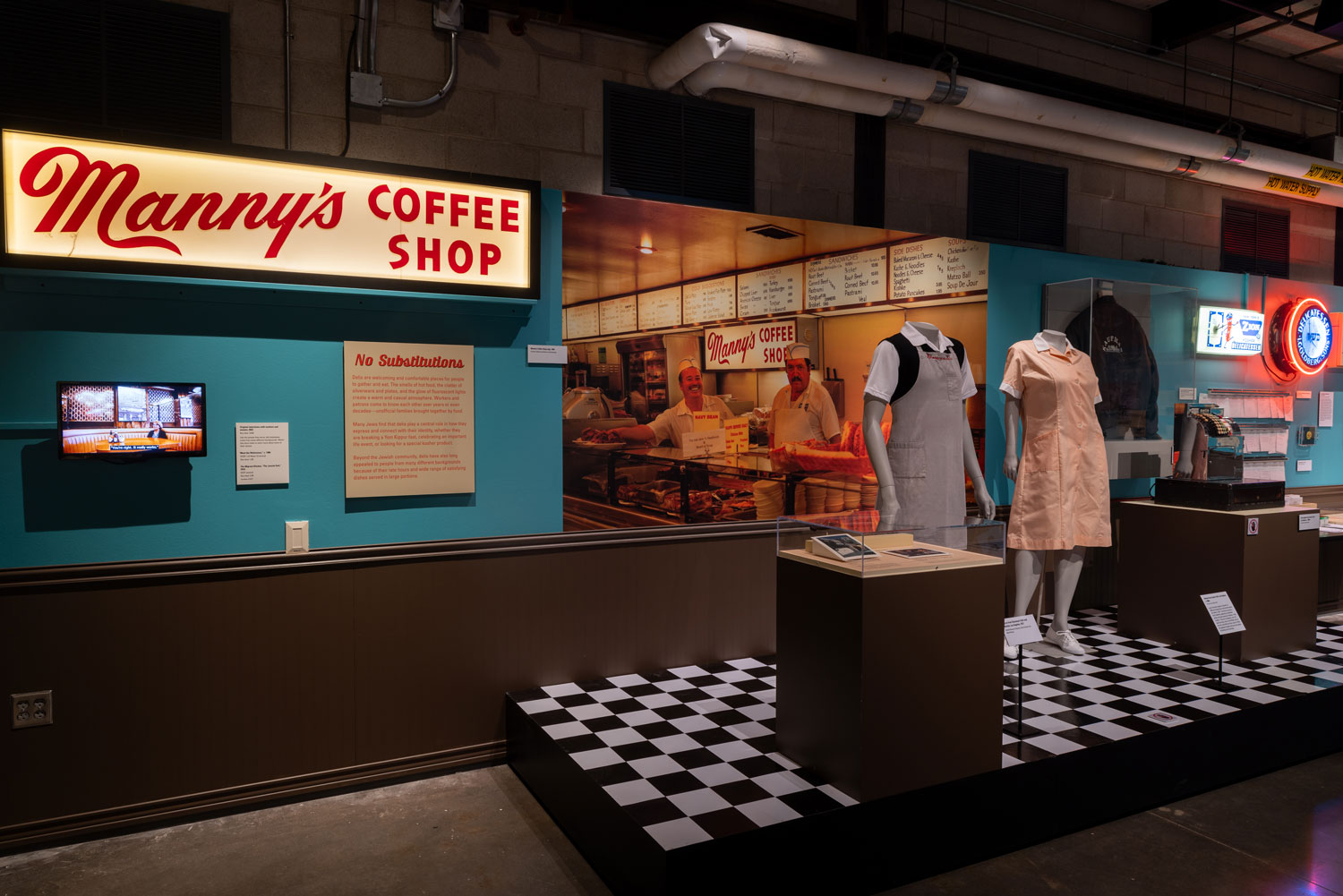
Here’s a question for you old-timers: Do you remember the metro area’s favorite carnival-themed deli — Barnum & Bagel in Skokie? Arielle Weininger sure does. “Oh, yes,” she laughs. “The horses from the carousel connected to the ceiling.”
Get Weininger, the chief curator at the Illinois Holocaust Museum and Education Center, talking about Chicago’s delis of yore and a whole nearly lost world opens up. “When I was growing up there was still an Ashkenaz in Wilmette, and we’d go there after swim lessons at the JCC.” She says “an Ashkenaz” because it was a beloved mini-chain started by Russian emigrés George and Ada Ashkenaz in Rogers Park before moving to the Gold Coast and then onward. She could tell you all about the greats and not so greats of yesteryear, like Itzkowitz Delicatessen, Eli’s Stage Delicatessen, or Salami & Gomorrah. Or Lyon’s, down on Maxwell Street, which became Nate’s and had a memorable cameo in The Blues Brothers.
You could try to snag Weininger for a kaffee klatsch or just go and see the heartfelt show she has curated at IHMEC, “I’ll Have What She’s Having: The Jewish Deli,” on exhibit through April 2024. This show, a version of which was originally developed by the Skirball Cultural Center in Los Angeles, takes a deep dive into the rise of the Jewish deli in America as a cultural icon and, as befits the setting, a place for Holocaust survivors to find community, process trauma, and remake their shattered lives anew.

Indeed, one of the most revelatory lessons of the exhibit is the way it presents the deli as the creation of a vast diaspora of people from far-flung origins united only by faith.
“None of the foods [that became deli staples] were specifically Jewish, but because of kashrut (the laws of Kosher) they figured out ways in which they would work,” says Weininger. “Dumpling soup came from Germany and Poland but bagels went all the way down to Turkey, where they’re known as simit.” Romanians brought pastrami to the table while Ukrainians contributed vareniki, and Russians brought a variation of Slavic blood sausage remade as kishke. “There was this new sense of community post war that was so important because nobody had any relatives.”
If you go, make sure to start with the wonderful film “To Life! To Deli!” that offers a perspective on the once-robust but now dwindling deli culture of greater Chicago, with a lot of love lavished on the city’s two great survivors — Manny’s in the South Loop and Kaufman’s in Skokie. The show itself is enlivened by Weininger’s spritely and engaging text, vintage photographs, and objects imbued with meaning, such as the meat grinder responsible for the famous chopped liver from the late, lamented Leon’s Deli. “When the daughter of the owners brought it to us, she had tears in her eyes,” said Weininger.
As I was going through the show, a woman came up to me and put her hand on my arm and said, “Don’t you miss Ashkenaz every day?” I didn’t have the heart to tell her I was neither a native Chicagoan nor as old as she had assumed, so I just said, “It was a great deli.”
Deli Delights

Of course the show made me obsessively hungry for deli after seeing it, so I did a little tour of some new places I had been meaning to look into and some classics that I needed to know better. Here are a few notes from recent visits:
The Bagel Restaurant and Deli: First time visit, and it won’t be the last. This is like every no-big-deal neighborhood restaurant in New York that’s kind of a deli, kind of a diner. I got a tomato stuffed with chicken salad that spoke deeply to my intersectional Jewish and Southern soul. The meal came with bagel crisps, four slices of challah and six (!) pickle spears for one person. 3107 N. Broadway, Lake View East
Tilly Bagel Shop: What a fantastic new bagel bakery! This sparse, bright shop serves a variety of familiar and more unusual flavors of both bagels and schmears, as well as a few sandwiches. I found the everything bagel, with anise seed giving the coating a lift, absolutely revelatory with caramelized onion cream cheese. Props to the garlic-rosemary bagel and the seasonal pumpkin bagel dusted with true cinnamon. The texture of these bagels is everything. 34 E. Balbo Dr., Loop
Schneider Deli: This mini-deli in the corner restaurant space fronting the Ohio House hotel is worthy of a stop after getting off the highway, particularly since it has dedicated parking spots. I honestly didn’t love everything from my first visit but there’s an eggplant and latke sandwich with tahini that will bring me back. 600 N. La Salle Dr., River North
Kaufman’s: If you go to the museum show midday and need to dive headfirst into a corned beef sandwich, Kaufman’s is just a few minutes away. My regular-cut medium fatty corned beef on rye with a side of chopped liver provided the most fun I’ve had in my car since I was 14. May Kaufman’s live forever; it’s a civic treasure. 4905 Dempster St., Skokie
Where Yibin All My Life?
Y’all, let me tell you about my new food obsession: Yibin Flaming Noodles. Much like dan dan noodles (and other Szechuan pastas), these are dry, soupless noodles. Despite the word “flaming,” sometimes translated as “burning,” they are not esophagus-scorchingly spicy. (From what I’ve read, the incendiary name came about because they can be lit like a wick.)
So what are they? Heaven. The sauce begins with a roasted rapeseed oil infused with chili and spices. The noodles are wheaty, stretchy, and long — thicker than angel hair, thinner than spaghetti. The toppings include finely minced bits of pickled mustard, scallion greens, ground pork, pulverized nuts, and sesame.
I’ve found two versions in Chinatown. Chef Xiong – Taste of Szechuan has the version I dream about. It looks plain at first but when you reach chopsticks in to stir, they pull up the russet oil from the bottom of the bowl, which stains the noodles and makes the various bits cling. At Dongpo Impression the noodles are icy cold and oilier, but the oil has a deep flavor wholly unlike roasted sesame oil. There’s also a fair bit of garlic in this bolder, livelier version.
Meanwhile, another noodle spot in Chinatown, Kajiken, has been getting attention for its signature mazesoba — a style of soupless ramen. This outpost of a Japanese chain is good in a chain-y way — clean lines, interesting menu, mechanical service — but I couldn’t ever imagine going back with these other two places around the corner.
Burger Tales
The couple sitting next to me at the bar at Argot — the new bistro inside Verve Wine in Lincoln Park — were perplexed by their $29 wagyu burgers, which arrived swimming in a thick, glossy, mahogany marchand de vin sauce made with red wine and reduced demiglace. “How are we supposed to eat these?” the woman wondered. “I guess like this,” the man said, bisecting his burger with a knife and gingerly picking a half up with thumb and forefinger. He polished his off and licked his fingers, while she gave up after an attempt with her hands and then knife and fork. “This is a weird burger,” she surmised.
Alas, when the manager came to ask about the meal, they both made enthusiastic sounds. “Everything was great!” the man said. She smiled, nodded, said, “I’m all done, thanks, it was great!” as the manager cleared her half-finished meal. People, people, people. Diners: Please share your truth. It only makes the restaurants better. Chefs: Think about the guests who order burgers because they’re afraid they won’t like anything else.



